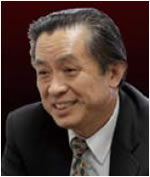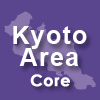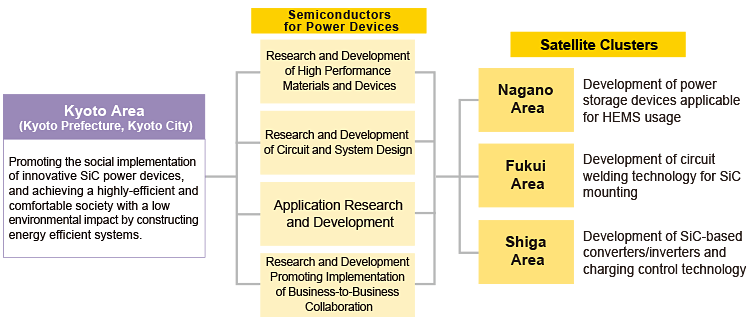[本文]
Kyoto Area


Research Director:
Seiichi Nishimoto
〈Satellite Cluster: Nagano Area, Fukui Area, Shiga Area〉
Construction of Highly-Efficient Energy to Achieve a Clean and Low Environmental Impact Society
Theme Overview
For the construction of high-efficiency energy use systems and the formation of networks to achieve a clean and low environmental impact society, the enhancement, full-scale popularization, and social implementation of next generation power electronics have been receiving worldwide attention. This is together with drastically enhancing energy saving effects of home electronics, motors, industrial robots, electric vehicles, trains, and electrical power systems, as well as the foundation for the early introduction and expansion of renewable energy, such as solar photovoltaic generation and wind power generation.
With the support of the primary period (fiscal year 2002-2007) and the second period (fiscal year 2008-2012: the name was changed from the Regional Innovation Cluster Program to the Regional Innovation Strategy Support Program) of the Knowledge Cluster Initiative, the Kyoto Area has achieved many results by developing industry-university-government collaboration research.
Especially, the industrialization development research of small and large capacity SiC power devices, conducted through close industry-university-government collaboration between Kyoto University and ROHM, a regional cooperation, has been drastically advanced. In 2010, they succeeded in the mass production of SiC Schottky diodes for the first time in Japan, and SiC power MOSFETs (metal-oxide-semiconductor field effect transistors) in the world. Furthermore, they succeeded in the mass production of Full-SiC power modules for the first time in the world in 2012. This led to the current research and development program.
An inverter whose prototype used mass-produced SiC power devices has been proven to have significant energy savings. It reduces power loss by 73% compared to conventional Si inverters. The high-performance application fields that devices with SiC power devices or SiC power modules installed are expected to unprecedentedly expand since they can achieve high efficiency (low energy loss), small-size, high temperature operation, and high frequency operation.
Toward Social Implementation
In this super cluster, in addition to the High Performance Material and Device Research and Development Group, the Circuit and System Design Research and Development Group, and the Application Research and Development Group centered on universities, a business-to-business collaboration installment promoting research and development group consisting of super cluster participating companies (device and module manufacturers / equipment manufacturers / system manufacturers) including development-oriented small-to-medium-sized enterprises has been formed to together strongly promote commercialization.
With this system, we will ensure global dominance by fiscal 2017, within the term of this project, by prototyping devices and systems such as small and high-frequency switching inverters, micro smart grids, and variable reluctance motors with installed SiC power devices or SiC power modules, and by evaluating the possibility of full-scale popularization and social implementation of SiC power electronics.

Kyoto Core Cluster
Construction of Highly-Efficient Energy to Achieve a Clean and Low Environmental Impact Society
Purpose
- Promoting the social implementation of innovative SiC power devices, and achieving a highly-efficient and comfortable society with a low environmental impact by constructing energy efficient systems.
- At the same time, increasing industrial competitiveness to drive the economic growth of Japan, and create a new green industry and employment to construct an economically affluent society by maintaining our global dominance in SiC power device mass production technology.
Overview
- The High Performance Material and Device Research and Development
Technological advance of the device by the base study of materials
- SiC power device, soller cell, rechargeable battery
- The Circuit and System Design Research and Development
Circuits and systems architecture to draw device properties
- high-frequency switching circuit, high-frequency gate drive circuit, motor control
- The Application Research and Development
Application construction and the proof that are most suitable for human life
- power packet, information sensing, cyber physical system
- A Business-to-Business Collaboration Installment Promoting Research and Development
The spread of social implementation through the manufacture by business-to-business collaboration
- micro smart grid
Participating Organizations
- Universities
- Kyoto University, Kyoto Institute of Technology, Osaka University, Kobe University, Nara Institute of Science and Technology, The University of Shiga Prefecture, Doshisha University, Ritsumeikan University
- Public Research and Development Institute
- Kyoto Municipal Institute of Industrial Technology and Culture, Kyoto Prefectural Technology Center for Small and Medium Enterprises
- Corporations
- IKS Japan Co.,Ltd., OMRON Corporation, KYOCERA Corporation, SAMCO Inc., SHIMADZU CORPORATION, Sumitomo Electric Industries, Ltd, NICHICON CORPORATION, NIDEC CORPORATION, HORIBA, Ltd., Murata Manufacturing Co., Ltd., ROHM Co., Ltd., and others (More to be added later)

Adoption Subjects
- Aichi Area
- Kyoto Area
